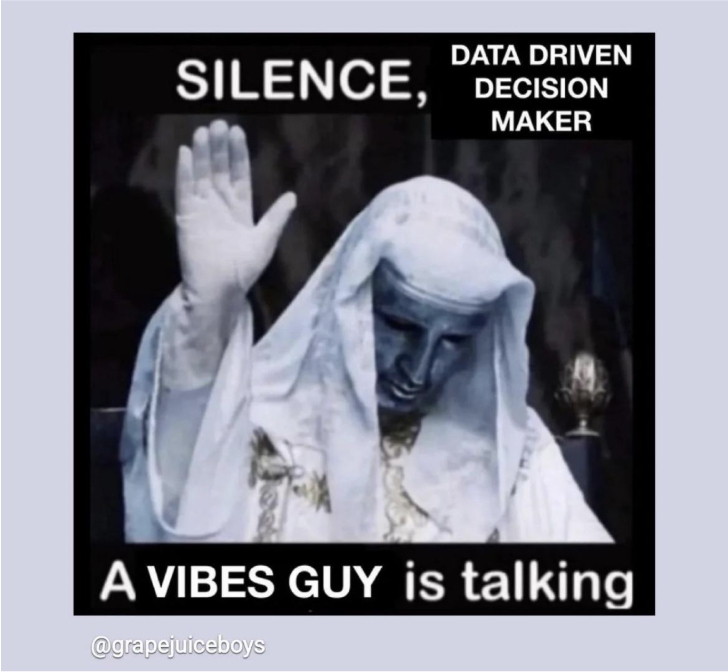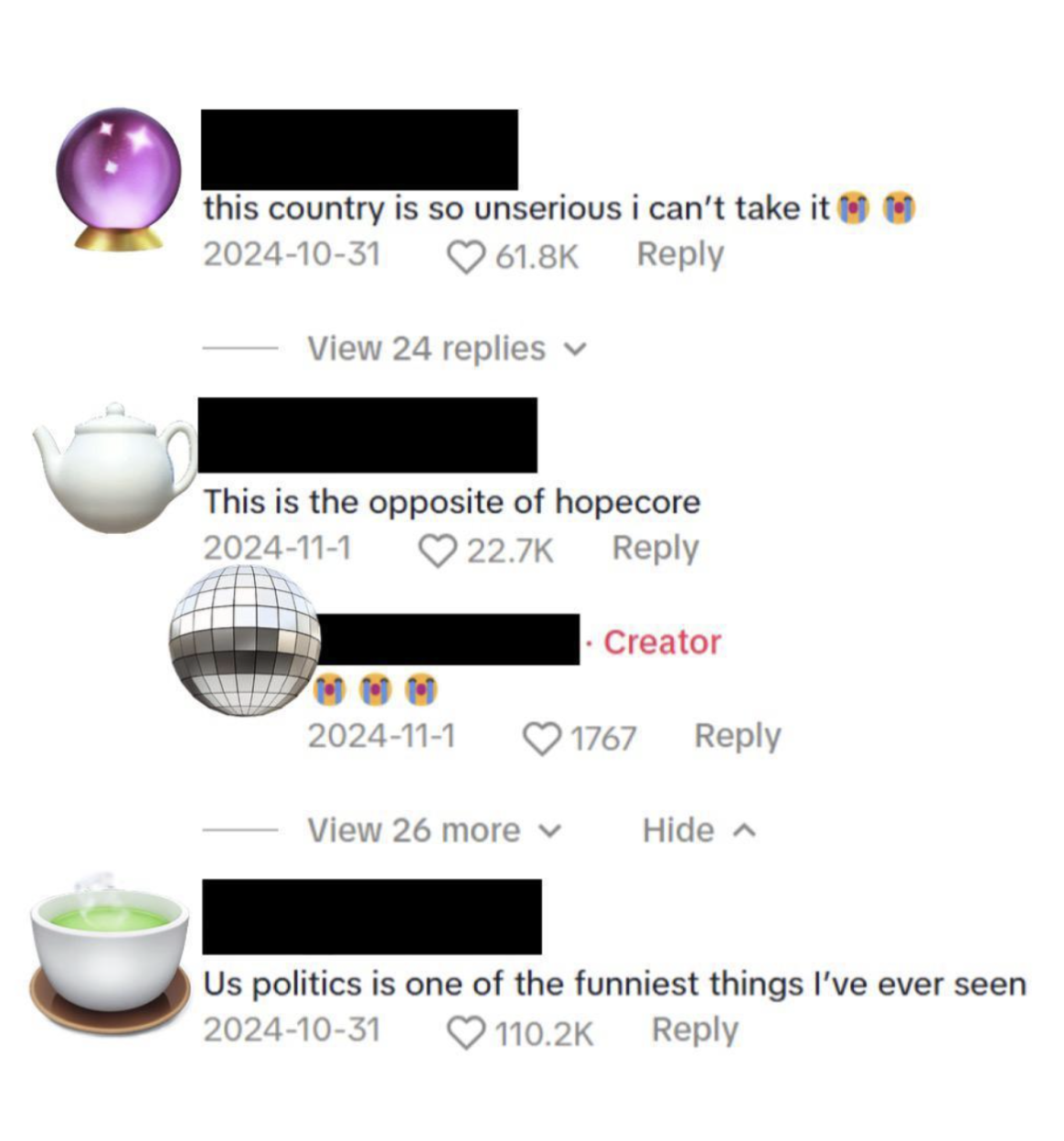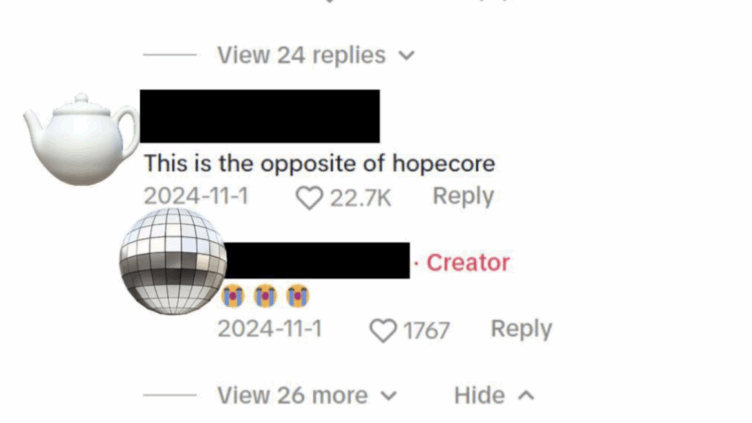The Vibes Are Off . . .
In the weeks following the 2024 U.S. presidential election, something was brewing on TikTok. 🤳 The short-form content creation and e-commerce platform is notorious for its for you page (FYP) homescreen, shaped by an algorithmic recommendation infrastructure using predictive modeling. Many use TikTok as a multimodal search engine: the more time spent viewing specific content, the more it will appear in your feeds. Thus, it was no surprise that Americans and Canadians alike spent the majority of 2024 watching a political reality unfolding offline populate their FYPs. Notably, this content wasn’t run of the mill campaign ads or political analyses. Instead, our feeds were filled with astrological chart readings of November 5, 2024: U.S. Election Day. Psychic mediums channeled predictions for a Kamala Harris presidency. As results trickled in that evening and shared a different outcome (Donald Trump’s victory), popular astrology creators like Medium Matilda encouraged followers to hold out for the “truth.” And yet, the predicted truth never arrived.
In the weeks following the U.S. election, astrological creator posts proliferated in our feeds. Countless astrocartographer creators consulted charts of the North American continent. Tarot creators laid out Celtic cross spreads, with the intention that the algorithmic infrastructure would send readings to the right audiences, “without hashtags.” Psychics used their bodies to channel communication from beyond that could help the world make sense of the outcome. The more we watched these videos, the more the algorithm sent us toward these unwieldy speculations sprinkled with these unverified vibes. We sensed that maybe, just maybe, a different outcome held possibility. While some commenters disregarded such labor as delusional, we were struck by how astrology creators commodify uncertainty as a political product.
Political astrology content is characterized by “hopium,” or a disillusionment to cling to hope in desperate political situations. TikTok users have embraced the conspirituality of uncertainty, feeding into what many called “Blue MAGA” or “Blue Anon.” Analogous to Trump supporters in the late 2010s and early 2020s who followed the ultra-conservative, far-right QAnon conspiracy movement, liberal TikTok creators and users alike dabbled in similar sense-making practices through psychic predictions and astrological analysis, perhaps as a last-ditch sensemaking effort.
Amidst much discourse about how AI is a (very ecologically consumptive) cop-out from being present, we want to seriously consider the way algorithmic recommendation systems and vernaculars are being developed to make sense of a (bleak) political future. We begin with a synthesis of conspirituality, or the entanglement of conspiracy and New Age beliefs1 in algorithmic recommendation systems. Our essay vibe checks us via two specific channels: (1) the arrival of hopecore memes on the FYP and (2) our subsequent sense-making of these FYP feelings through the OpenAI GPT personae “Tea Leaf Whisperer.” Treat the waters ahead not as a concrete solution 🙅🧪️, but as a critical-creative riding of academic waves to tell a story about forging hope from the FYP. 🌊 While our essay does not directly focus on TikTok’s role in the splintering of U.S. politics, we investigate how the platform’s automated algorithmic recommendation system offers constructed pathways for occult content and the hope for political futures.

: :
Hopecore Origins
Internet scholars have long documented the use of computing systems to mediate meaning-making. For example, Sophie Bishop’s concept of “algorithmic gossip” considers how influencers collectively interpret how algorithmic systems share information,2 and Michael Ann DeVito analyzes algorithmic “folk theories”: user-generated discourses that rely on first-hand experiences and observations about platform visibility to weave together the blurred boundaries of algorithmic recommendation infrastructures.3 Scholars themselves develop a variety of methodological tools to look into algorithmic sorting functions of the Feed as a “black box.”4 The platonic platform user likewise engages with their feed with speculation, projection, and guestimation as much as they do with a conscious knowledge of enumerated power rankings and copyright flags.
Algorithmic gossip and folklore point towards political fantasy as a contemporary extension of hopecore, a recent memetic trend and Internet aesthetic centering appreciation of human relationships, objects of significance, or otherwise “wholesome” artifacts that instill inspiration and positivity in the viewer. Within TikTok’s cultural production, hopecore memes originated in late 2023, featuring “feel-good” edits of athletes, award-winning actors, or animals. Weaving together inspirational clips with classic songs from artists like Peter, Paul, & Mary and the Mamas & the Papas, hopecore content’s evocative enmeshment of audio and visual content motivates viewers to appreciate the fragility and beauty of humanity, encouraging them to persevere through difficult moments. Serving as media containers for our silly little desires and hopes, hopecore memes, such as the one below, curate wholesome aspirations of optimistic sense-making during a decade of unprecedented times.

As the first “influencer election,” cultural production surrounding the 2024 U.S. presidential campaign cycle leaned into these hopecore aesthetics. A now-viral video posted by @best_of_politique, a political meme account, features a montage of campaign footage set to Aphex Twin’s “QKThr,” a popular track used for hopecore content. As the slow cadence of the ambient electronic track builds, the video begins with footage of Donald Trump’s campaign event at a McDonald’s drive-through window, slinging fries into greasy paper bags.

The whimsical melancholy of the tune builds as we see an older clip of Kamala Harris’s exclaiming to a reporter, “I love good news! Love good news! I just love good news!” Older clips of U.S. political figures such as Barack Obama, Joe Biden, and Hillary Clinton are weaved together, portraying the media excess of American politics as a point of humorous nostalgia that can be reflected upon during a perilous present. Here, hopecore functions ironically, as comments compare the U.S. to a “reality television series” and “this is the opposite of hopecore!”

The intermingling of hopecore with political analysis initially presented cultural production that basked in the ironic belief in functioning political system. (Plot twist: America isn’t passing the vibe check!) However, the satirical excessive absurdity of hopecore memes is washed away in its convergence with occult-centered cultural production. The advent of astrology creators using their practices to uncover the uncertain implications of political turmoil invokes a different iteration of hopecore content: one that uses the obfuscated black boxes of algorithmic recommendation to present earnest sensemaking practices that attempt amelioration of the unknown. Is astrological and occult-based hopecore content truly meant to find us?
: :
Reading the AI Tea Leaves
Let’s have a cup of tea. Tea leaf reading, or tasseography, is a form of divination that interprets patterns in tea leaves remaining at the bottom of a cup. The practice has roots across Asia and Europe. One might turn to one of the many OpenAI tea leaf readers to make sense of political events beyond the imagination of consensus. Seeking patterns in randomness can give a feeling of agency when the world feels unpredictable. Whether via coffee tabletop or AI desktop, tea leaf readings resonate with hopecore. They are a practice of deceleration, observation, and building significance in something as (ostensibly) banal as a cup of tea.
We tried to make sense of these algorithmic trends of hopium through the “disruptor” tech of our decade, “artificial intelligence.” Amid the many extensions and aggregations that have climbed aboard the software kits of this moment, one app being advertised to us was the “Tea Leaf Whisperer”: a ChatGPT persona developed by Richard Allen Legg. It offers interpretation of tea leaves from a figurative cup you would be pretending to sip with OpenAI. On a critical whim, not knowing what to do with all this hopium, we asked this extension: What do the tea leaves say about the U.S. TikTok ban?
The Tea Leaf Whisperer provided a digital teacup and listed shapes emerging in the tea leaves: The Scales, The Tower, the Web, and The Path. We are also told the Tower is a “a symbol of authority, structure, and at times, isolation, . . . it hints at government interventions and the barriers they may create.”As if too on the nose about Internet connectivity, there is a Web “[s]preading near the base is the image of a web, delicate yet interconnected. This speaks of TikTok’s role in linking people globally—a network of creativity and shared moments.” These dregs are good at telling us that there are waves of uncertainty we must continue to contend with. What do we make of this? The Tea Leaf Whisperer concluded not with a thesis statement, or hypothesis for hope. Rather, it concluded with a word from our sponsors. Hope, like the commodity form under platformization, is rendered contingent. The Whisperer, as an OpenAI extension, is a machine that sells our dreams, cope, and hope back to us.
At the end, we are starkly reminded that we don’t have cups of tea in our hands, or our bellies. It takes about 32 ounces of boiling water to brew your standard tea. How much did it take to brew a conversation with the Tea Leaf Whisperer? We are left empty.
: :
Endnotes
- See Kelley Cotter, Julia R. DeCook, Shaheen Kanthawala, and Kali Foyle, “In FYP We Trust: The Divine Force of Algorithmic Conspirituality,” International Journal of Communication 16 (2022): 2911–34; Charlotte Ward and David Voas, “The Emergence of Conspirituality,” Journal of Contemporary Religion 26, no. 1 (2011): 103–21.
- Sophie Bishop, “Managing Visibility on YouTube through Algorithmic Gossip.” New Media & Society 21, nos. 11–12 (2019): 2589–2606.
- Michael Ann DeVito, “How Transfeminine TikTok Creators Navigate the Algorithmic Trap of Visibility Via Folk Theorization,” CSCW ’22: Proceedings of the ACM on Human-Computer Interaction 380(2022): 1-31.
- Angelé Christin, “The Ethnographer and the Algorithm: Beyond the Black Box,” Theory & Society, 49, nos. 5–6 (2020): 897-918.
